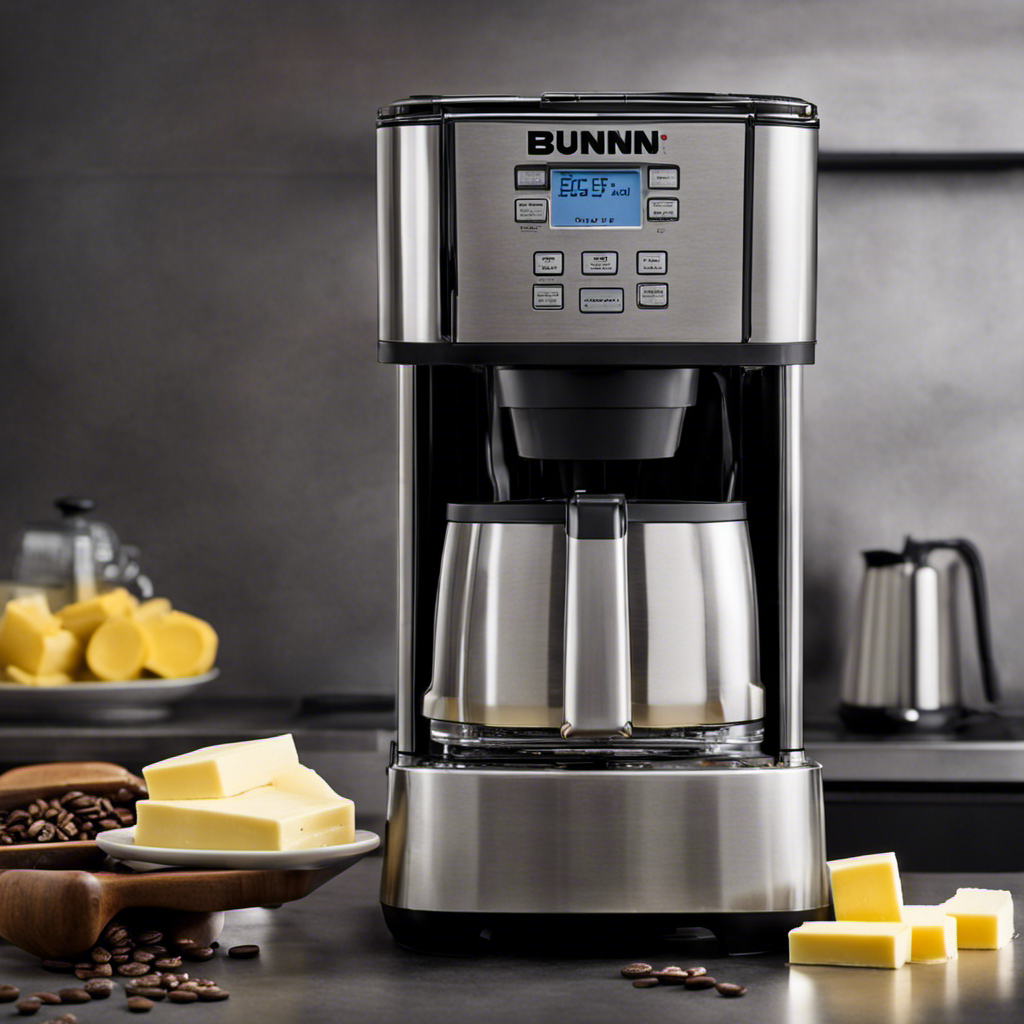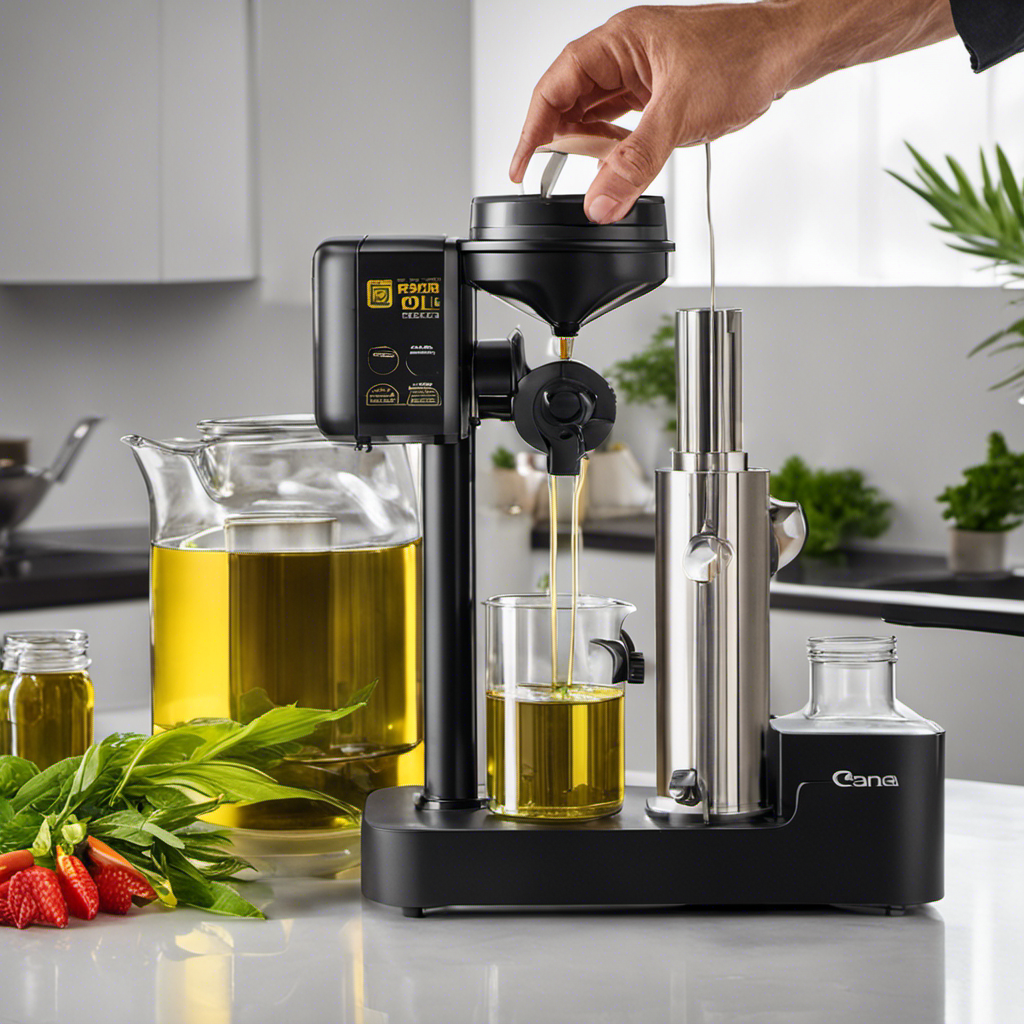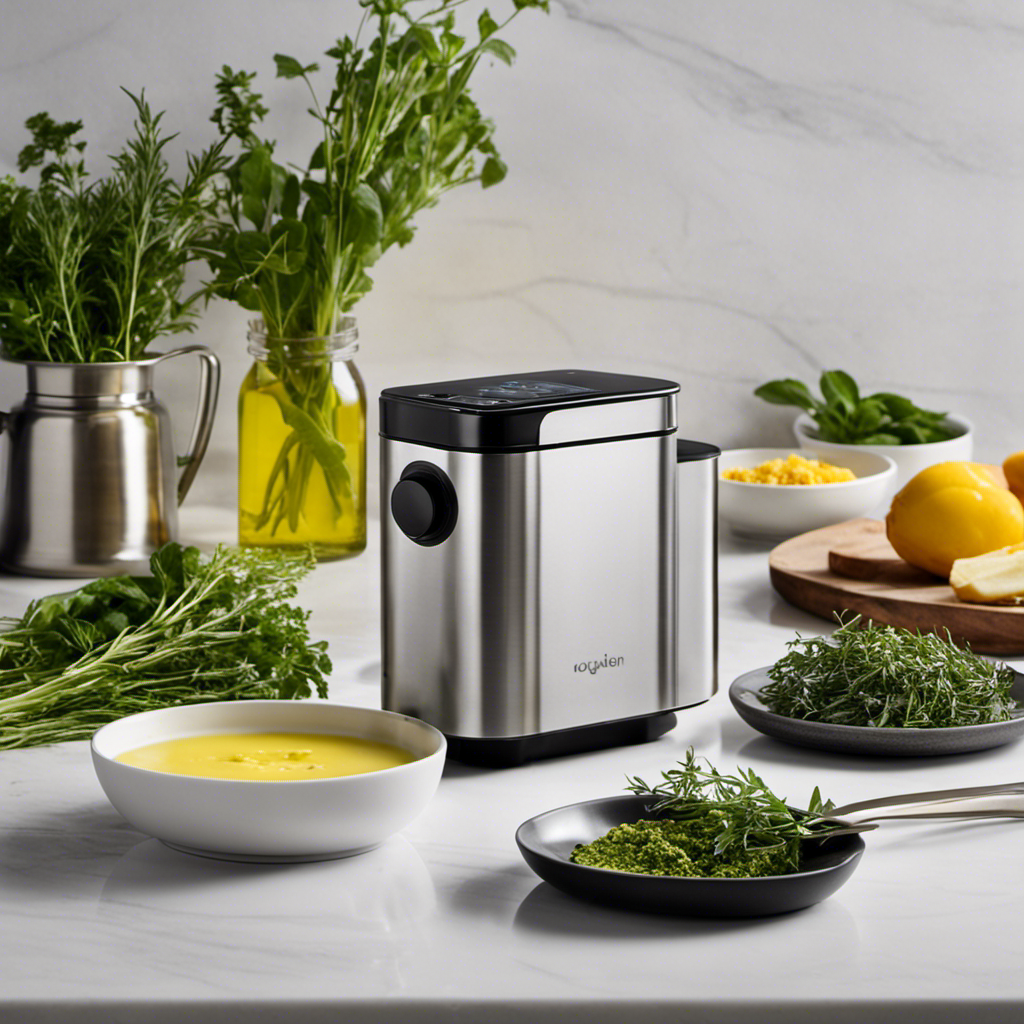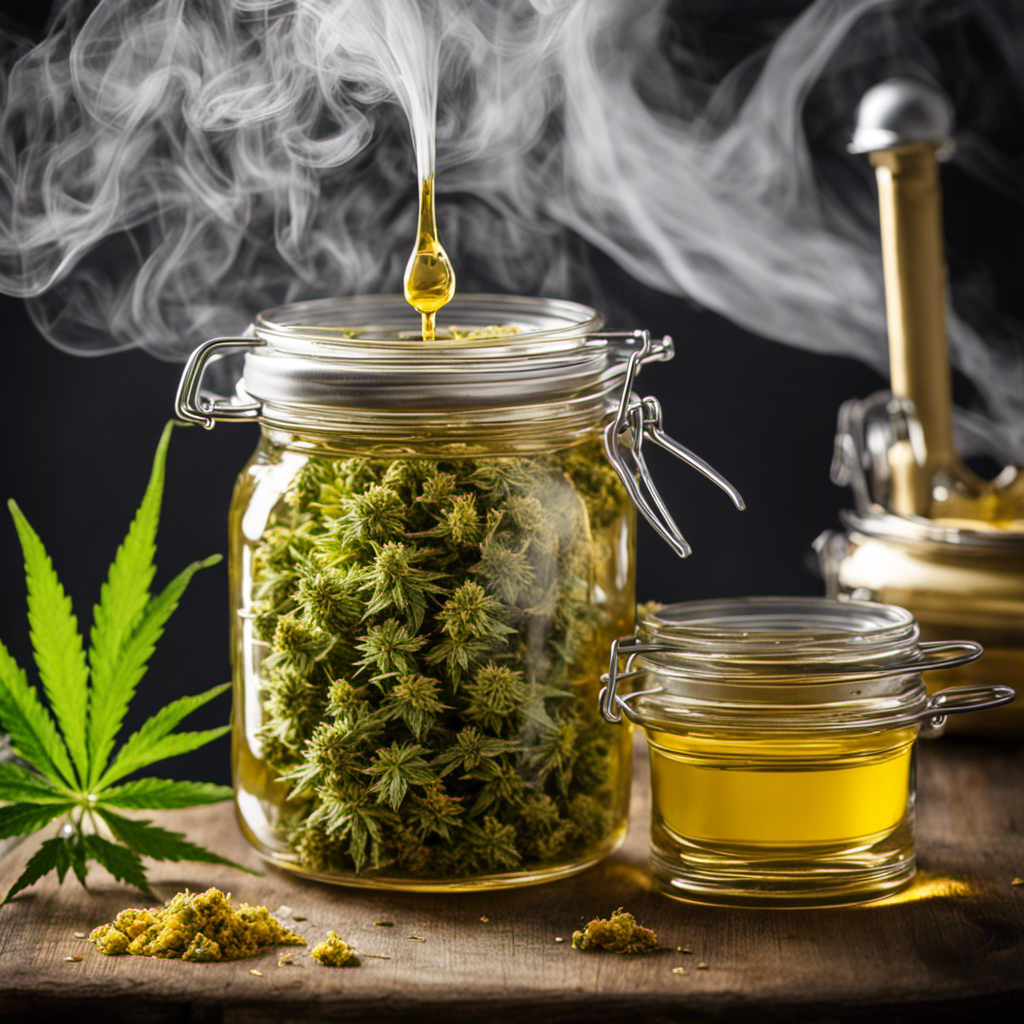Alright, everyone, pay attention! Have you ever thought about what happens when a glob of butter accidentally gets into your favorite Bunn coffee maker? Well, don’t worry, because I’m here to help you learn how to clean up that buttery mess from your coffee maker.
In this step-by-step article, I’ll show you how to:
- Disassemble your Bunn coffee maker
- Remove the butter residue
- Clean and sanitize your coffee maker
- Maintain your Bunn coffee maker like a pro
So grab your cleaning supplies and let’s get to work!
Key Takeaways
- Butter residue can alter the flavor and texture of brewed coffee in a Bunn coffee maker.
- Using butter in coffee makers is not recommended by manufacturers.
- Thoroughly cleaning and drying all parts after each use is essential to remove butter residue.
- Regular cleaning of the coffee maker prevents the build-up of butter residue and ensures better-tasting coffee.
Understanding the Impact of Butter in Your Coffee Maker
You should understand the impact of butter in your coffee maker before attempting to clean it.
Butter can have a significant effect on the taste of your coffee. When butter is left inside the coffee maker, it can melt and mix with the brewed coffee, altering its flavor and texture. The buttery taste can be overpowering and may not be desirable to everyone.
It is important to note that using butter in coffee makers is not recommended by manufacturers, as it can lead to clogs and damage to the machine. However, there are alternative uses for butter in coffee makers, such as adding a small amount to the carafe before brewing to enhance the richness of the coffee.
It is essential to clean the coffee maker thoroughly if butter has been used to prevent any lingering flavors in future brews.
Gathering the Necessary Supplies for Cleaning
First, gather all the supplies needed to complete the cleaning process. Understanding the importance of proper maintenance, it is crucial to have the right tools at hand. Here are three items you will need:
-
White vinegar: This natural cleaning agent is effective in removing stubborn residue and eliminating odors. Mix equal parts vinegar and water to create a solution for cleaning your coffee maker.
-
Clean, lint-free cloth: A soft cloth is essential for wiping down the exterior of your coffee maker. Look for a cloth that doesn’t leave any lint behind to ensure a thorough cleaning.
-
Toothbrush or small brush: For those hard-to-reach areas, a toothbrush or small brush can be invaluable. Use it to clean the crevices and corners of your coffee maker, ensuring that every nook and cranny is free from butter residue.
Step-by-Step Guide to Disassembling the Coffee Maker
To begin disassembling the coffee maker, start by carefully removing the exterior panels. Before proceeding, it’s important to take certain disassembling precautions to ensure your safety and prevent any damage to the machine.
Make sure the coffee maker is unplugged and allow it to cool down completely. Use a screwdriver to remove the screws holding the panels in place. Once the panels are removed, you can access the inner components of the coffee maker.
Troubleshooting common issues during disassembly includes being mindful of delicate parts, such as wires and connectors, and keeping track of screws and other small parts to avoid losing them. Take your time and follow the disassembly process step by step to avoid any mishaps.
Removing Butter Residue From the Different Parts of the Coffee Maker
When it comes to removing butter residue from the different parts of the coffee maker, there are two main options to consider: chemical cleaners and natural cleaners.
Chemical cleaners are often more powerful and can quickly dissolve stubborn residue, but they may leave behind harmful chemicals that could affect the taste of your coffee.
On the other hand, natural cleaners like vinegar or baking soda are safer to use and can effectively remove residue, but they may require more time and effort.
To prevent future residue, it is important to thoroughly clean and dry all parts of the coffee maker after each use and avoid using excessive amounts of butter or other oily substances in the brewing process.
Chemical Vs Natural Cleaners
If you’re looking for a quick and effective solution, you might consider using a natural cleaner to remove the butter residue from inside your Bunn coffee maker. Natural cleaners have their pros and cons when compared to chemical cleaners. Here are three things to consider:
-
Safety: Natural cleaners are typically made from non-toxic ingredients, making them safer for you and the environment. Chemical cleaners, on the other hand, may contain harsh chemicals that can be harmful if not handled properly.
-
Effectiveness: Natural cleaners can be just as effective as chemical cleaners when it comes to removing butter residue. They often use ingredients like vinegar or lemon juice, which have natural cleaning properties. However, some stubborn stains may require the use of a chemical cleaner.
-
Residue: Natural cleaners tend to leave less residue behind compared to chemical cleaners. This is beneficial as leftover residue can affect the taste of your coffee. Chemical cleaners may require extra rinsing to ensure all traces are removed.
Preventing Future Residue
To prevent future residue, you should regularly maintain your Bunn coffee maker by cleaning it thoroughly after each use. Residue buildup can have long-term effects on the performance of your coffee maker, affecting the taste and quality of your coffee.
When butter residue is left inside the coffee maker, it can become sticky and attract more debris over time. This buildup can clog the internal components and affect the flow of water, leading to slower brewing times and potential damage to the machine.
To avoid these issues, ensure that you clean the coffee maker promptly after each use, removing any butter residue and thoroughly rinsing all parts. This will help maintain the efficiency and functionality of your Bunn coffee maker and ensure a consistently great cup of coffee.
Now, let’s move on to the next section and learn about cleaning and sanitizing the coffee maker components.
Cleaning and Sanitizing the Coffee Maker Components
First, gather all the necessary cleaning supplies for sanitizing the components of your Bunn coffee maker.
To ensure a thorough cleaning and prevent any residue buildup, follow these cleaning hacks and troubleshooting tips:
-
Vinegar Solution: Mix equal parts white vinegar and water in a container. This solution is effective in removing mineral deposits and coffee stains. Run this mixture through the coffee maker, allowing it to sit for about 15 minutes before rinsing it with clean water.
-
Cleaning Brush: Use a small, soft-bristled brush to clean the nooks and crannies of the coffee maker, such as the crevices around the spray head and the filter basket. This will help remove any remaining residue and ensure a proper cleaning.
-
Paper Filter: Place a paper filter in the filter basket and run a cycle with just water. This will help remove any remaining vinegar or cleaning solution, leaving your coffee maker fresh and ready for use.
Reassembling and Maintaining Your Bunn Coffee Maker
Once you have finished reassembling the components, make sure to regularly maintain your Bunn coffee maker for optimal performance.
To start, ensure that all the parts are securely fitted and tightened. Check the brew funnel, spray head, and decanter for any blockages or residue buildup.
If you notice any issues, such as slow brewing or weak coffee, troubleshoot by inspecting the water inlet valve, thermostat, and spray head tube. Clean or replace any faulty parts as necessary.
Additionally, descale your coffee maker regularly to remove mineral deposits that can affect the taste and performance. Remember to follow the manufacturer’s instructions for cleaning solutions and frequency.
Frequently Asked Questions
How Long Does It Take for Butter Residue to Build up Inside a Coffee Maker?
Butter residue buildup inside a coffee maker depends on frequency of use and cleaning habits. If not removed promptly, it can accumulate over time and affect the taste of your coffee.
Can I Use a Regular Dish Soap to Clean the Coffee Maker Components?
Sure, I can use dish soap to clean the coffee maker components. However, for a more thorough and effective cleaning, using vinegar or baking soda is recommended. Lemon juice can also be used as an alternative to dish soap.
Is It Safe to Use Vinegar as a Cleaning Agent for the Coffee Maker?
Using vinegar as a coffee maker cleaner is effective due to its acidity and ability to dissolve mineral deposits. However, it may leave a lingering odor. Alternative cleaning agents, such as citric acid, can be used for odor-free cleaning.
How Often Should I Clean and Sanitize My Bunn Coffee Maker?
Cleaning and sanitizing my Bunn coffee maker regularly ensures its longevity and optimal performance. Proper maintenance includes descaling to remove mineral deposits and following manufacturer’s guidelines. Remember, "A stitch in time saves nine."
Can I Use the Same Cleaning Process for Other Types of Coffee Makers?
Yes, different types of coffee makers require different cleaning methods. It’s important to follow the manufacturer’s instructions. Using natural cleaning agents can be beneficial for coffee maker maintenance, as they are less likely to leave residue or damage the machine.
Conclusion
In conclusion, cleaning the butter residue from inside your Bunn coffee maker may seem like a daunting task, but it can be easily accomplished with the right supplies and a step-by-step approach.
By disassembling the coffee maker and thoroughly removing the butter residue from each part, you can ensure that your coffee maker is clean and ready to brew delicious coffee once again.
Remember to sanitize the components and properly reassemble the coffee maker to maintain its functionality.
With these detailed steps, your coffee maker will be back to its butter-free glory in no time.










